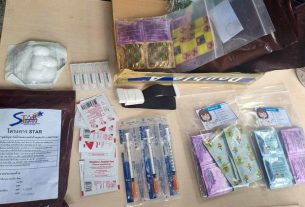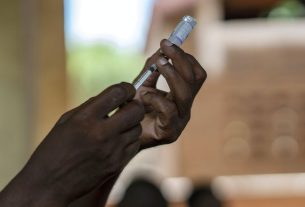By Nicole Cech as told to Hallie Levine
When I was diagnosed with psoriatic arthritis 2 years ago at the age of 24, I almost wept with relief. For years, I’d experienced puzzling symptoms. Dark purple-brown flakes on the back of my neck and in the cracks of my feet. Bouts of fatigue were so disabling I couldn’t concentrate at work. Joint pain kept me from doing my favorite workouts.
Suddenly, it seemed that pieces of a missing jigsaw puzzle had appeared. While it was hard to digest that I had a form of inflammatory arthritis, I was also relieved that I knew what was going on. Hopefully, I could move on and live my life.
Unfortunately, it did take me years to get a diagnosis. My story isn’t uncommon. Research suggests psoriatic disease – both psoriasis and psoriatic arthritis – is underdiagnosed in Black patients. We’re also less likely to get appropriate treatments for our psoriatic arthritis such as biologics. Here’s my story, in the hope that it will help others.
A Puzzling Rash
I experienced psoriasis for years before my official diagnosis. I first noticed it at the age of 7, after a bout of strep throat. I experienced a full-body outbreak like my current psoriasis flares. My doctors were completely puzzled as to what it was. They diagnosed eczema, even though it didn’t look like it. My rash wasn’t red but dark purple-brown. It also didn’t itch.
As I got older, I noticed other, unexplainable symptoms too. I’ve always been active, often walking as much as 5 miles a day. But that level of exercise began to cause backache. I noticed that I couldn’t get through workouts without experiencing joint pain. I remember doing a class that involved a lot of jumping and running, and by the time I got halfway through it, I began to cry. My primary care physician sent me to specialists, including dermatologists and rheumatologists, who told me the pain was all in my head.
A Moment of Clarity
I spent 3 years working at a skincare company. I spent my days with dermatologists and was very well-versed in medical journals. I began to realize that something about my diagnosis of eczema didn’t add up. I decided to seek out a Black dermatologist. The first thing she said to me when she saw me was, “it’s not eczema.” She explained to me that while many dermatologists look for pink or red patches with silvery-white scales to diagnose psoriasis, on black skin, they usually appear as purple patches with gray scales.
She also took the time to ask me if I had any other unusual symptoms. When I brought up the fatigue and joint pain, she told me that she thought I might have psoriatic arthritis. She prescribed Cosentyx, a biologic often used to treat the condition. It works by targeting a certain protein, interleukin 17 that’s associated with psoriatic inflammation.
After I saw the dermatologist, I went to see a rheumatologist to confirm the diagnosis. I left the appointment in tears. She was very dismissive. She literally said to me, “It sounds like your dermatologist has it, so I’m not sure what else you want me to do,” and left the room without even saying goodbye. As soon as I got into my car, I did a Google search for other rheumatologists in my area. I found a great doctor who took a much more holistic approach. She said to me that her goal was for me to live my life and do anything I wanted to do. She eventually prescribed me a new biologic, Humira, which was even more effective for my symptoms than Cosentyx. She also kept a very close eye on me. She would give me steroid injections to relieve extreme joint pain, and made sure that other medications I took, such as nonsteroidal anti-inflammatories, didn’t mess up my stomach.
Living My Life
Today, my psoriatic arthritis isn’t gone, but it’s well managed. I’m on a different biologic called Enbrel, which I take as an injection once a week. I’ve also changed my mindset. My goal is pain reduction, not 100% freedom from chronic pain. I want to just keep it controlled enough that I can do what I need to do, both at work and at home. I’ve also learned to mentally adjust to my limits and to be kind and gentle with myself when I hit a wall of fatigue.
Part of my adjusting to life with psoriatic arthritis is also adopting a role as an advocate. As a Black woman, I realize that many medical professionals simply don’t see my pain as real. As a result, I’m conditioned to not see it as real either. I think that’s one reason that even with my diagnosis, I was still hard on myself if I couldn’t do everything I wanted or needed to do. There’s this unspoken expectation that as a woman of color, you’re not allowed to feel pain, and if you do, you must push through it. I don’t need to look any further than my mom and my grandmother. They grew up in eras where if they did feel pain, they just kept going. While neither of them has psoriatic arthritis, there are lots of Black people who live with it and aren’t getting the care they need.
That’s one reason why I’ve become involved with CreakyJoints, the international digital community for patients with arthritis and their caregivers, which is part of the Global Healthy Living Foundation, a nonprofit organization working to improve the quality of life of people who live with chronic illnesses such as psoriatic arthritis. I’ve spoken with Shilpa Venkatachalam, PhD, MPH, director of their Patient-Centered Research Operations and Ethical Oversight, about some of the glaring health disparities we see in psoriatic arthritis. She’s made the point that although it appears that more often white populations are diagnosed with this disease than people of color and black populations, there may be many Black and Latinx people living with this disease who simply go undiagnosed or underdiagnosed owing to disparities in access to care and other insurance-related barriers that lead to suboptimal care.
Differences in care are compounded by the fact that lesions on darker skin often go unrecognized, misdiagnosed, or overlooked at the time of diagnosis. The solution isn’t to just tell patients that they need to advocate for themselves. While that is important, we need to address system barriers, for example, medical schools need to build larger and more inclusive image banks so that they can adequately train students about what psoriatic lesions look like on darker color skin. The sooner patients get diagnosed, the more quickly they can be treated with cutting-edge medications such as biologics, which improve their prognosis.
As for me, I consider myself lucky that I followed my instincts and went to see a Black dermatologist who listened to me. I’m also lucky to have an incredible husband, who supports me and doesn’t dismiss my symptoms. He has his own health issues, so he gets it. I’m also very fortunate to have my own creative outlets. I write and make art, and those two things have allowed me to get through the harder pieces of my diagnostic journey. It brings me joy, especially on those days when I feel trapped in my body. It’s a powerful way to help me cope.



